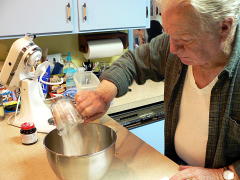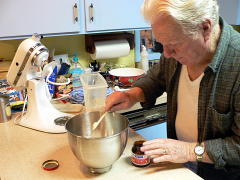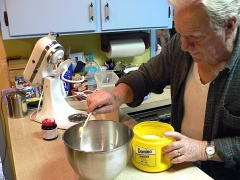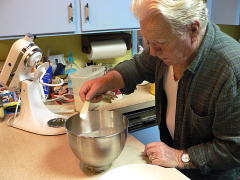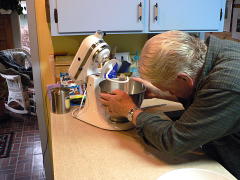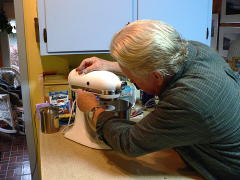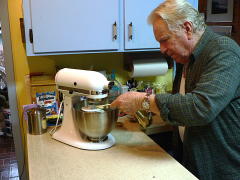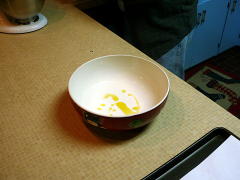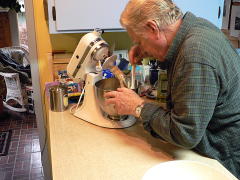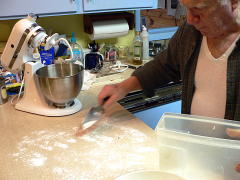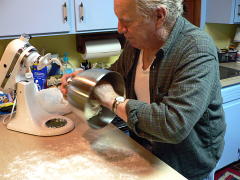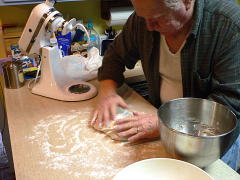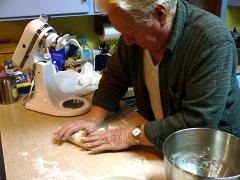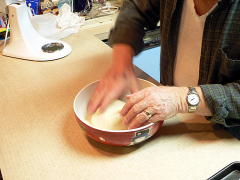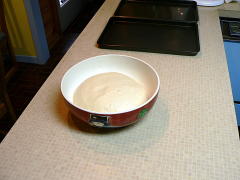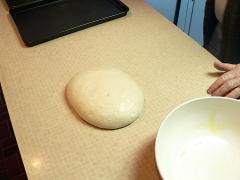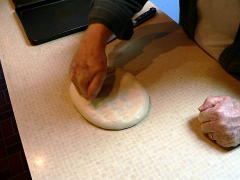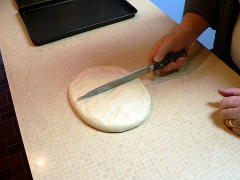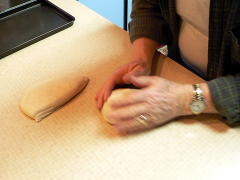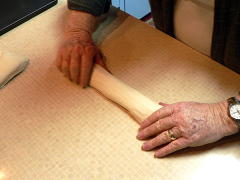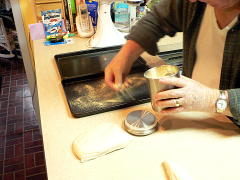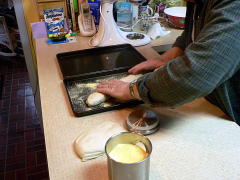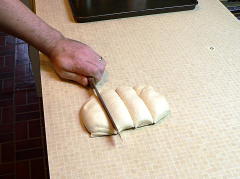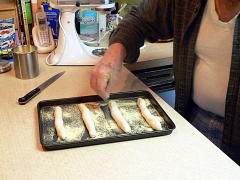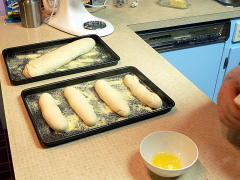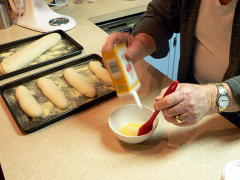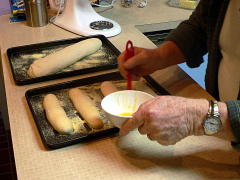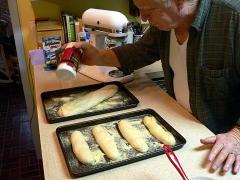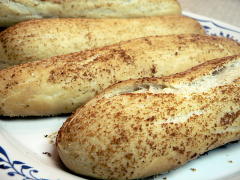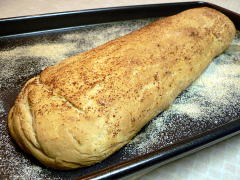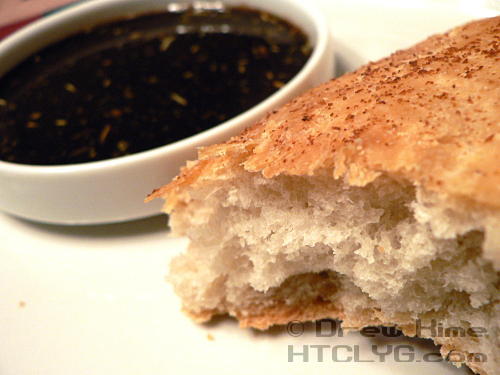My father-in-law, Lou, finally got a stand mixer for Christmas, and doesn’t have to borrow mine when he wants to make something any more. So the first thing he decided to do is start making bread. I brought him over the recipe for crusty Italian bread and he went to town.
But of course he can’t just do plain Italian bread like I did. He has to do garlic breadsticks. Which I’m totally cool with, because I was staying for dinner.
Ingredients
1 package (1/4 ounce, 2-1/2 teaspoons) active dry yeast
1-1/4 cups warm water (105°-115°)
3 cups unbleached flour or all-purpose flour
2 teaspoons sugar
1 teaspoon salt
1 tablespoon olive oil
cornmeal for dusting
Topping
2-3 Tablespoons butter
1 Tablespoon garlic powder
Directions
This is mostly the same process I showed last time for making crusty Italian bread. Combine a cup of flour, the yeast, and a teaspoon of sugar, stir in the water, and let it rest until the yeast is bubbling.
Add the salt, the rest of the flour and the rest of the sugar.
Figure out how to get the bowl attached to the new mixer and mix on low until the flour is incorporated.
Add the olive oil, then turn it up to medium and let it knead for 8-10 minutes.
If you add the oil before mixing in the flour, it will coat the flour and keep it from absorbing water. You don’t want that, or it won’t develop gluten, the springy protein that lets bread rise.
When the dough is just about ready, put a little olive oil in the bottom of a clean, smooth bowl.
This is what the dough will be rising in, so the smoother it is the easier the dough will come out later.
Scrape down the sides a few times while kneading the dough to make sure everything gets pulled in. Be extra careful to dig down to the bottom. Sometimes you get a cap of dough over a bit of dry flour at the bottom.
When the dough is ready, turn it out onto a floured surface.
Knead it by hand, adding more flour as needed, until it’s no longer sticking to the surface.
Transfer to the bowl with the oil in it, and roll the dough all around. You want the surface completely coated with oil to keep it from sticking, and to keep it from drying out.
Cover the bowl with a wet tea towel, or with plastic wrap. This is again to keep it from drying out while rising.
Put the bowl in a warm place for about an hour to an hour-and-a-half, until the yeast has doubled in size.
TIP: If it’s cold in your kitchen, a perfect place for the bread to rise is inside your oven. Not turned on, but with the oven light on. That will give it just enough warmth to get the yeast going.
Once it’s doubled in size, turn it out and punch it down gently to release most of the gas.
Unless you’re making a really monster loaf, cut the dough in half.
With one half, roll it into a tight ball. Cup your hands over it, resting your pinky fingers lightly on the surface, and make loose circular motions.This will pull the top tight while it rounds out.
You can leave it round like this, or roll out to a longer shape.
Dust a baking sheet with cornmeal to keep the bread from sticking, and place the dough on it. Make sure there’s plenty of room for it to rise to double its size again.
You can do the same with the other half, or divide it in fourths to make breadsticks.
(Yup, that’s my hand getting involved. I don’t seem to be able to keep out of things in the kitchen.)
Roll those out the same way as the larger loaf.
Melt the butter and mix in the garlic powder.
Hey wait, that looks like that bread has already had its second rise. Yup, it has, but next time I’ll do the butter before it rises. You’ll see why in a minute.
Brush the garlic butter onto the loaves.
Add a little kosher salt.
Go back and click those last two pictures to see the larger versions. See how the big loaf looks sort of deflated? Yeah, brushing on the melted butter after letting it rise was bad timing.
So after brushing with garlic butter, put the baking sheets back in the oven — still just the light turned on. Let them rise for another hour or so, until doubled in height again.
Bake at 400 ° for 25-30 minutes, until golden brown on top.
The smaller loaves will be done faster, of course. You can probably pull them as soon as the top starts to split. The larger loaf is done when a thump on the bottom makes a hollow sound instead of a dull thud.
Serve with olive oil and balsamic vinegar with herbs for dipping …
… or as a side with salad or pasta.
And that’s it.
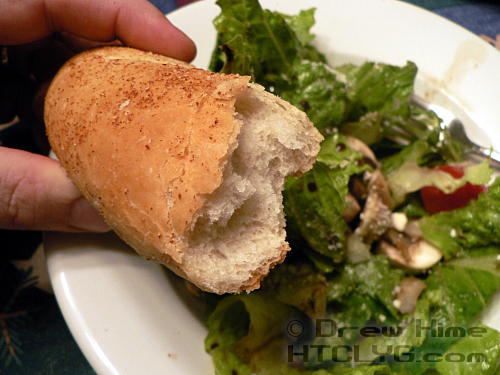
Ingredients
- 1 package (1/4 ounce, 2-1/2 teaspoons) active dry yeast
- 1-1/4 cups warm water (105-115°)
- 3 cups unbleached flour or all-purpose flour
- 2 teaspoons sugar
- 1 teaspoon salt
- 1 tablespoon olive oil
- cornmeal for dusting
- 2-3 Tablespoons butter
- 1 Tablespoon garlic powder
Instructions
Combine one cup of flour, one teaspoon of sugar and the yeast. Add the warm water and stir quickly. Let this rest for 10 minutes, until the yeast is active and bubbling.
Add the rest of the flour and sugar, and the salt, and mix at low speed until the flour is incorporated. Add the olive oil and mix at medium speed for 8-10 minutes, until it's smooth and satiny. Optionally knead by hand for 8-10 minutes.
Turn the dough out onto a floured surface and roll into a ball. Knead in enough flour to keep it from sticking to the surface. Place in an oiled bowl and cover with plastic wrap. Put in a warm place for 1 to1-1/2 hours, until it has doubled in size. Turn out onto a floured surface and punch down.
Divide into eight pieces and roll each one out long and skinny, about as thick as your thumb. Place on a baking sheet dusted with cornmeal. Let rise until doubled in size.
Bake at 400° for 20-30 minutes, until golden brown and the top is starting to split.
